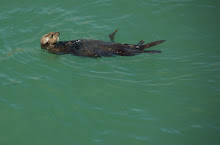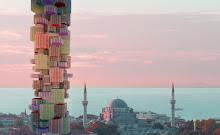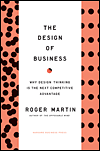Contemporary Arab art!? Who knew such a thing existed?
After all there is such a dearth of information on contemporary art from the Arab world. Judging from textbooks, journals and the collections in museums around the world, I would have concluded, if I did not know any better, that artistic creation in the Middle East and South Asia ceased after the construction of the Taj Mahal in the mid-16oo's - which is not the case.
With recent successes of art fairs in the wealthier countries in the Gulf like Dubai and wealthy patrons who are not only building up their own personal collections but looking to build museums - prominent western auction houses have taken note and are making huge profits auctioning contemporary Arab art. London based Christie's auction house opened up its Dubai office in 2005. In October 2007, Christie's held their 3rd auction for Arab and Iranian art. During the course of that one evening they sold US$12.6 million of art. In April 2008, they sold US$18 million.
Despite this new found interest and artistic exchange between Europe and the Gulf - museums and galleries in the United States however, have been painfully slow to broaden their scope of their collections. So with the hope of building peace and understanding through cultural diplomacy - the Levantine Cultural Center (LCC) in LA decided to take matters into their own hands. "If the mountain will not come to Mohammed, Mohammed will go to the mountain." Opening on June 20th, 2009 in Los Angeles, at the LCC is the first gallery to focus solely on contemporary Arab art. The first show curated by me, titled "inside/outside and other oxymorons," features the work of three incredible artists - Sama Alshaibi, Vahé Berberian, Adnan Charara whose life stories alone are legendary. Each of their lives have been marred by political conflict and strife which forced them into a more nomadic, migrant existence. The art they create in a variety of mediums are not only a political commentary, but also symbol of hybridity, multi-culturalism, the human condition, their own respective journeys and our collective experience in globalized world.
During the time I spent curating this show, I not only developed tremendous respect and admiration for their creativity and their art but I was also in awe of these people. Having endured some of the worst of humanity with wars and genocide, these three artists represent the best of humanity with their kindness, their joie de vivre, their generosity and openness.
 Sama Alshaibi (1973) is a photography and mixed media artist who draws from her own cultural experiences from Iraq, Palestine and the United States. Born into a family affected by war, displacement and exile from two homelands, Palestine and Iraq - much of her work focuses on the themes of restlessness, hybrid identity, exile and displacement and the subtle negotiations and shifts between personal and family history and expectations. Her images are full of longing and nostalgia. What I find most appealing with her work is the emotional vulnerability and honesty. Her art is a peak into her own internal dialogue and her and her family's struggles as they come to terms with the culture and homes they lost and the new life they gained.
Sama Alshaibi (1973) is a photography and mixed media artist who draws from her own cultural experiences from Iraq, Palestine and the United States. Born into a family affected by war, displacement and exile from two homelands, Palestine and Iraq - much of her work focuses on the themes of restlessness, hybrid identity, exile and displacement and the subtle negotiations and shifts between personal and family history and expectations. Her images are full of longing and nostalgia. What I find most appealing with her work is the emotional vulnerability and honesty. Her art is a peak into her own internal dialogue and her and her family's struggles as they come to terms with the culture and homes they lost and the new life they gained. Vahé Berberian (1955) a painter, novelist, playwright, actor and director lost 74 members of his family during the Armenian genocide. It all happened before he was born but he has carried the heavy weight of this legacy all his life. The deportation of his parents from Turkey, the war in Beirut, the European counter-culture (which he became a part of in his teens), the city of Los Angeles (where he has been a resident since 1976) and his own hybrid identity (which includes a mix of Armenian, Lebanese, European and American cultures) have provided him rich fodder for his work. Tremendously affected by his family history and yet a student of all cultures and people, his art is a study of aesthetics and of the human condition. His paintings while seemingly simple are full of raw emotion. His goal is to create beauty out of imperfection. His paintings are reminiscent of a human being - beauty is found in the vulnerability and the flaws.
Vahé Berberian (1955) a painter, novelist, playwright, actor and director lost 74 members of his family during the Armenian genocide. It all happened before he was born but he has carried the heavy weight of this legacy all his life. The deportation of his parents from Turkey, the war in Beirut, the European counter-culture (which he became a part of in his teens), the city of Los Angeles (where he has been a resident since 1976) and his own hybrid identity (which includes a mix of Armenian, Lebanese, European and American cultures) have provided him rich fodder for his work. Tremendously affected by his family history and yet a student of all cultures and people, his art is a study of aesthetics and of the human condition. His paintings while seemingly simple are full of raw emotion. His goal is to create beauty out of imperfection. His paintings are reminiscent of a human being - beauty is found in the vulnerability and the flaws. Adnan Charara (1962) known to most as a painter, sculptor and print-maker prefers to be known as a visual poet or philosopher. While his colorful, animated and whimsical creations seem rather light-hearted, they are deceptively full of commentary and emotion. Having spent most of his childhood shuttled between Lebanon and Sierra Leone (depending on the political situation at the time) and then eventually moving to the United States, much of his work focuses on physical and emotional migration, the merging of cultures and accumulation of knowledge through life's journeys and the formation of new identity. Through his art, he explores what is gained and lost through migration. While Charara's style is uniquely his own, his exposure to multiple cultures is clearly reflected in his art. He draws from African tribal art, Islamic calligraphy and European cubist art.
Adnan Charara (1962) known to most as a painter, sculptor and print-maker prefers to be known as a visual poet or philosopher. While his colorful, animated and whimsical creations seem rather light-hearted, they are deceptively full of commentary and emotion. Having spent most of his childhood shuttled between Lebanon and Sierra Leone (depending on the political situation at the time) and then eventually moving to the United States, much of his work focuses on physical and emotional migration, the merging of cultures and accumulation of knowledge through life's journeys and the formation of new identity. Through his art, he explores what is gained and lost through migration. While Charara's style is uniquely his own, his exposure to multiple cultures is clearly reflected in his art. He draws from African tribal art, Islamic calligraphy and European cubist art.The inside/outside and other oxymorons art exhibition opens on Saturday June 20th, 2009 from 6PM to 10PM at the new inside/outside gallery at the Levantine Cultural Center on 5998 West Pico Boulevard, Los Angeles, California 90035. The exhibition will run until the end of July. Stop by and take a look - let me know what you think. I can't wait introduce you to these are artists and for you to see their work. It might just give you a different perspective on what is coming out of the Middle East.
For more information click here.
"The art of the global diaspora is often hopefully described as the art of the future - a projected future of multi-cultural societies, well traversed territories and translated traditions."
"Culture is not static.... We are fluid; we are human; we are experience. And within that experience we are transformed by our contact with each other."
"The global village is increasingly internalized within us."





























